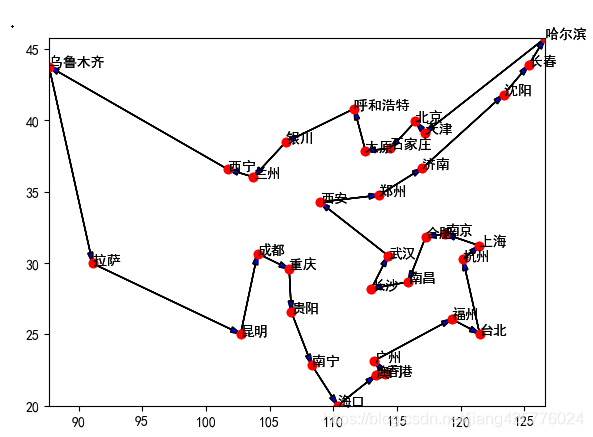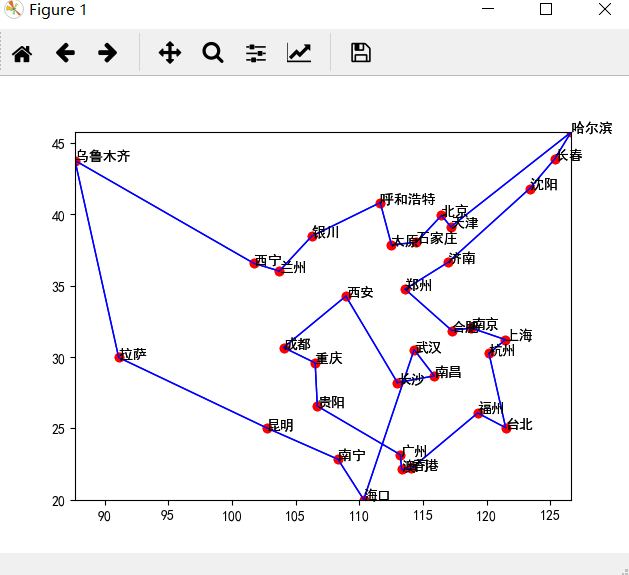版权声明:本文为博主原创文章,遵循 CC 4.0 by-sa 版权协议,转载请附上原文出处链接和本声明。
本文链接:https://blog.csdn.net/jiang425776024/article/details/84532018
效果图:
程序会动态的展示迭代过程,40以内城市大概迭代300次能收敛到最优;这里是用中国城市地理坐标直接做欧式距离计算,实际上可以根据问题作出调整。
Github:https://github.com/425776024/TSP-GA-py
测试数据:china.csv:
北京 ;116.46;39.92 天津 ;117.2;39.13 上海 ;121.48;31.22 重庆 ;106.54;29.59 拉萨 ;91.11;29.97 乌鲁木齐 ;87.68;43.77 银川 ;106.27;38.47 呼和浩特 ;111.65;40.82 南宁 ;108.33;22.84 哈尔滨 ;126.63;45.75 长春 ;125.35;43.88 沈阳 ;123.38;41.8 石家庄 ;114.48;38.03 太原 ;112.53;37.87 西宁 ;101.74;36.56 济南 ;117;36.65 郑州 ;113.6;34.76 南京;118.78;32.04 合肥;117.27;31.86 杭州;120.19;30.26 福州;119.3;26.08 南昌;115.89;28.68 长沙;113;28.21 武汉;114.31;30.52 广州;113.23;23.16 台北;121.5;25.05 海口;110.35;20.02 兰州;103.73;36.03 西安;108.95;34.27 成都;104.06;30.67 贵阳;106.71;26.57 昆明;102.73;25.04 香港;114.1;22.2 澳门;113.33;22.13
TSP-GA.py
# -*- encoding: utf-8 -*- import numpy as np import pandas as pd from DW import * class TSP(object): citys = np.array([]) #城市数组 citys_name = np.array([]) pop_size = 50 #种群大小 c_rate = 0.7 #交叉率 m_rate = 0.05 #突变率 pop = np.array([]) #种群数组 fitness = np.array([]) #适应度数组 city_size = -1 #标记城市数目 ga_num = 200 #最大迭代次数 best_dist = -1 #记录目前最优距离 best_gen = [] #记录目前最优旅行方案 dw = Draw() #绘图类 def __init__(self, c_rate, m_rate, pop_size, ga_num): self.fitness = np.zeros(self.pop_size) self.c_rate = c_rate self.m_rate = m_rate self.pop_size = pop_size self.ga_num = ga_num def init(self): tsp = self # tsp.load_Citys() #加载城市数据 tsp.load_Citys2() #加载城市数据 tsp.pop = tsp.creat_pop(tsp.pop_size) #创建种群 tsp.fitness = tsp.get_fitness(tsp.pop) #计算初始种群适应度 tsp.dw.bound_x = [np.min(tsp.citys[:, 0]), np.max(tsp.citys[:, 0])] #计算绘图时的X界 tsp.dw.bound_y = [np.min(tsp.citys[:, 1]), np.max(tsp.citys[:, 1])] #计算绘图时的Y界 tsp.dw.set_xybound(tsp.dw.bound_x, tsp.dw.bound_y) #设置边界 def creat_pop(self, size): pop = [] for i in range(size): gene = np.arange(self.citys.shape[0]) #问题的解,基因,种群中的个体:[0,...,city_size] np.random.shuffle(gene) #打乱数组[0,...,city_size] pop.append(gene) #加入种群 return np.array(pop) def get_fitness(self, pop): d = np.array([]) #适应度记录数组 for i in range(pop.shape[0]): gen = pop[i] # 取其中一条基因(编码解,个体) dis = self.gen_distance(gen) #计算此基因优劣(距离长短) dis = self.best_dist / dis #当前最优距离除以当前pop[i](个体)距离;越近适应度越高,最优适应度为1 d = np.append(d, dis) # 保存适应度pop[i] return d def get_local_fitness(self, gen, i): ''' 计算地i个城市的邻域 交换基因数组中任意两个值组成的解集:称为邻域。计算领域内所有可能的适应度 :param gen:城市路径 :param i:第i城市 :return:第i城市的局部适应度 ''' di = 0 fi = 0 if i == 0: di = self.ct_distance(self.citys[gen[0]], self.citys[gen[-1]]) else: di = self.ct_distance(self.citys[gen[i]], self.citys[gen[i - 1]]) od = [] for j in range(self.city_size): if i != j: od.append(self.ct_distance(self.citys[gen[i]], self.citys[gen[i - 1]])) mind = np.min(od) fi = di - mind return fi def EO(self, gen): #极值优化,传统遗传算法性能不好,这里混合EO #其会在整个基因的领域内,寻找一个最佳变换以更新基因 local_fitness = [] for g in range(self.city_size): f = self.get_local_fitness(gen, g) local_fitness.append(f) max_city_i = np.argmax(local_fitness) maxgen = np.copy(gen) if 1 < max_city_i < self.city_size - 1: for j in range(max_city_i): maxgen = np.copy(gen) jj = max_city_i while jj < self.city_size: gen1 = self.exechange_gen(maxgen, j, jj) d = self.gen_distance(maxgen) d1 = self.gen_distance(gen1) if d > d1: maxgen = gen1[:] jj += 1 gen = maxgen return gen def select_pop(self, pop): #选择种群,优胜劣汰,策略1:低于平均的要替换改变 best_f_index = np.argmax(self.fitness) av = np.median(self.fitness, axis=0) for i in range(self.pop_size): if i != best_f_index and self.fitness[i] < av: pi = self.cross(pop[best_f_index], pop[i]) pi = self.mutate(pi) # d1 = self.distance(pi) # d2 = self.distance(pop[i]) # if d1 < d2: pop[i, :] = pi[:] return pop def select_pop2(self, pop): #选择种群,优胜劣汰,策略2:轮盘赌,适应度低的替换的概率大 probility = self.fitness / self.fitness.sum() idx = np.random.choice(np.arange(self.pop_size), size=self.pop_size, replace=True, p=probility) n_pop = pop[idx, :] return n_pop def cross(self, parent1, parent2): """交叉p1,p2的部分基因片段""" if np.random.rand() > self.c_rate: return parent1 index1 = np.random.randint(0, self.city_size - 1) index2 = np.random.randint(index1, self.city_size - 1) tempGene = parent2[index1:index2] # 交叉的基因片段 newGene = [] p1len = 0 for g in parent1: if p1len == index1: newGene.extend(tempGene) # 插入基因片段 if g not in tempGene: newGene.append(g) p1len += 1 newGene = np.array(newGene) if newGene.shape[0] != self.city_size: print('c error') return self.creat_pop(1) # return parent1 return newGene def mutate(self, gene): """突变""" if np.random.rand() > self.m_rate: return gene index1 = np.random.randint(0, self.city_size - 1) index2 = np.random.randint(index1, self.city_size - 1) newGene = self.reverse_gen(gene, index1, index2) if newGene.shape[0] != self.city_size: print('m error') return self.creat_pop(1) return newGene def reverse_gen(self, gen, i, j): #函数:翻转基因中i到j之间的基因片段 if i >= j: return gen if j > self.city_size - 1: return gen parent1 = np.copy(gen) tempGene = parent1[i:j] newGene = [] p1len = 0 for g in parent1: if p1len == i: newGene.extend(tempGene[::-1]) # 插入基因片段 if g not in tempGene: newGene.append(g) p1len += 1 return np.array(newGene) def exechange_gen(self, gen, i, j): #函数:交换基因中i,j值 c = gen[j] gen[j] = gen[i] gen[i] = c return gen def evolution(self): #主程序:迭代进化种群 tsp = self for i in range(self.ga_num): best_f_index = np.argmax(tsp.fitness) worst_f_index = np.argmin(tsp.fitness) local_best_gen = tsp.pop[best_f_index] local_best_dist = tsp.gen_distance(local_best_gen) if i == 0: tsp.best_gen = local_best_gen tsp.best_dist = tsp.gen_distance(local_best_gen) if local_best_dist < tsp.best_dist: tsp.best_dist = local_best_dist #记录最优值 tsp.best_gen = local_best_gen #记录最个体基因 #绘图 tsp.dw.ax.cla() tsp.re_draw() tsp.dw.plt.pause(0.001) else: tsp.pop[worst_f_index] = self.best_gen print('gen:%d evo,best dist :%s' % (i, self.best_dist)) tsp.pop = tsp.select_pop(tsp.pop) #选择淘汰种群 tsp.fitness = tsp.get_fitness(tsp.pop) #计算种群适应度 for j in range(self.pop_size): r = np.random.randint(0, self.pop_size - 1) if j != r: tsp.pop[j] = tsp.cross(tsp.pop[j], tsp.pop[r]) #交叉种群中第j,r个体的基因 tsp.pop[j] = tsp.mutate(tsp.pop[j]) #突变种群中第j个体的基因 self.best_gen = self.EO(self.best_gen) #极值优化,防止收敛局部最优 tsp.best_dist = tsp.gen_distance(self.best_gen) #记录最优值 def load_Citys(self, file='china_main_citys.csv', delm=','): # 中国34城市经纬度 data = pd.read_csv(file, delimiter=delm, header=None).values #china_main_citys.csv数据太大,只计算部分如:湖南省关键字的 self.citys = data[data[:, 0] == '湖南省', 4:] self.citys_name = data[data[:, 0] == '湖南省', 2] self.city_size = self.citys.shape[0] def load_Citys2(self, file='china.csv', delm=';'): # 中国34城市经纬度 data = pd.read_csv(file, delimiter=delm, header=None).values self.citys = data[:, 1:] self.citys_name = data[:, 0] self.city_size = data.shape[0] def gen_distance(self, gen): #计算基因所代表的总旅行距离 distance = 0.0 for i in range(-1, len(self.citys) - 1): index1, index2 = gen[i], gen[i + 1] city1, city2 = self.citys[index1], self.citys[index2] distance += np.sqrt((city1[0] - city2[0]) ** 2 + (city1[1] - city2[1]) ** 2) return distance def ct_distance(self, city1, city2): #计算2城市之间的欧氏距离 d = np.sqrt((city1[0] - city2[0]) ** 2 + (city1[1] - city2[1]) ** 2) return d def draw_citys_way(self, gen): ''' 根据一条基因gen绘制一条旅行路线 :param gen: :return: ''' tsp = self dw = self.dw m = gen.shape[0] tsp.dw.set_xybound(tsp.dw.bound_x, tsp.dw.bound_y) for i in range(m): if i < m - 1: best_i = tsp.best_gen[i] next_best_i = tsp.best_gen[i + 1] best_icity = tsp.citys[best_i] next_best_icity = tsp.citys[next_best_i] dw.draw_line(best_icity, next_best_icity) start = tsp.citys[tsp.best_gen[0]] end = tsp.citys[tsp.best_gen[-1]] dw.draw_line(end, start) def draw_citys_name(self, gen, size=5): ''' 根据一条基因gen绘制对应城市名称 :param gen: :param size: text size :return: ''' tsp = self m = gen.shape[0] tsp.dw.set_xybound(tsp.dw.bound_x, tsp.dw.bound_y) for i in range(m): c = gen[i] best_icity = tsp.citys[c] tsp.dw.draw_text(best_icity[0], best_icity[1], tsp.citys_name[c], 10) def re_draw(self): #重绘图;每次迭代后绘制一次,动态展示。 tsp = self tsp.dw.draw_points(tsp.citys[:, 0], tsp.citys[:, 1]) tsp.draw_citys_name(tsp.pop[0], 8) tsp.draw_citys_way(self.best_gen) def main(): tsp = TSP(0.5, 0.1, 100, 500) tsp.init() tsp.evolution() tsp.re_draw() tsp.dw.plt.show() if __name__ == '__main__': main()
DW.py
#DW.py import matplotlib.pyplot as plt from matplotlib.lines import Line2D import matplotlib.animation as animation class Draw(object): bound_x = [] bound_y = [] def __init__(self): self.fig, self.ax = plt.subplots() self.plt = plt self.set_font() def draw_line(self, p_from, p_to): line1 = [(p_from[0], p_from[1]), (p_to[0], p_to[1])] (line1_xs, line1_ys) = zip(*line1) self.ax.add_line(Line2D(line1_xs, line1_ys, linewidth=1, color='blue')) # def draw_arrow(self, p_from, p_to): # if p_from.shape[0] != 2 and p_to.shape[0] != 2: # print('error,', p_from, p_to) # return # p_from = list(p_from) # p_to = list(p_to) # self.ax.arrow(p_from[0], p_from[1], p_to[0] - p_from[0], p_to[1] - p_from[1], # length_includes_head=True, # head_width=(self.bound_x[1] - self.bound_x[0]) / 100, # head_length=(self.bound_x[1] - self.bound_x[0]) / 50, # fc='blue', ec='black') def draw_points(self, pointx, pointy): self.ax.plot(pointx, pointy, 'ro') def set_xybound(self, x_bd, y_bd): self.ax.axis([x_bd[0], x_bd[1], y_bd[0], y_bd[1]]) def draw_text(self, x, y, text, size=8): self.ax.text(x, y, text, fontsize=size) def set_font(self, ft_style='SimHei'): plt.rcParams['font.sans-serif'] = [ft_style] # 用来正常显示中文标签

